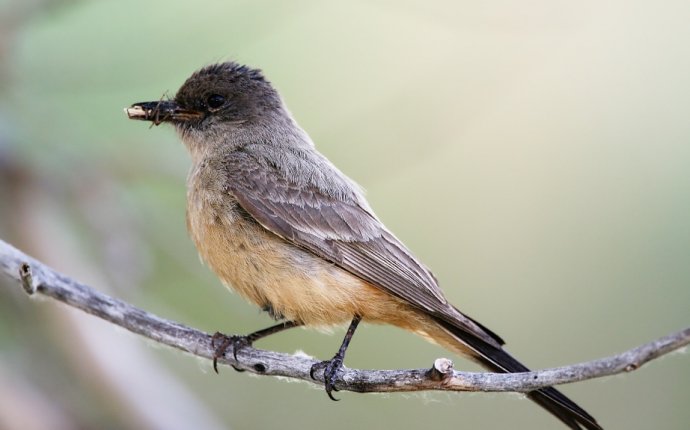
Western Phoebe
This widespread western species is frequently seen perching on bushes, boulders, fences, and utility wires. Polytypic (4 ssp.; 3 in North America). Length 4.5".
Grayish brown above; darkest on wings and head, especially lores and behind eye. Breast and throat are paler, more grayish; contrast with tawny-cinnamon belly and undertail coverts. Contrasting black tail is particularly obvious in flight. Juvenile: plumage is briefly held. Similar to adult but browner, with 2 cinnamon wing bars and cinnamon tips to the feathers on the upperparts.
Variation is complicated by individual variation and wear. Compared to more widespread nominate, northwestern breeding yukonensis (Alaska and Northwest Territories to coastal Oregon) is smaller billed, with deeper orange underparts and deeper gray upperparts. Resident quiescens (deserts of southeastern California and southwestern Arizona) is paler brownish gray above and paler tan or buff on belly.
Yellow-bellied kingbirds can appear similar in bright light (especially the western kingbird), but all have a heavier bill, dark mask, yellow belly, and olive upperparts; unlike phoebes, they do not dip the tail. Female and immature vermilion flycatchers have a white throat and white chest with brown streaks; most show pale supercilium contrasting with dark auriculars.
Call: typical call is a thin, plaintive, whistled, slightly downslurred pee-ee. Song: a fast whistled pit-tsear, often given in flight.
Common. Breeding: a variety of open and dry habitats from tundra to desert, usually with cliffs, canyons, rocky outcroppings, or human-made structures for nesting. Migration: early in spring, late in fall. Bulk of migrants arrive from Colorado to east of the Sierra Nevada in California late March–mid-April; southern British Columbia. late March–mid-April; and Alaska early to mid-May. In fall, most depart Alberta late August–early September.; Colorado and Oregon late August–September. Vagrant: casual over most of the East (late fall–early winter) with records for every state and province except Delaware, District of Columbia, Maryland, New Hampshire, West Virginia, Nunavut, and Prince Edward Island.
—From the National Geographic book Complete Birds of North America,








